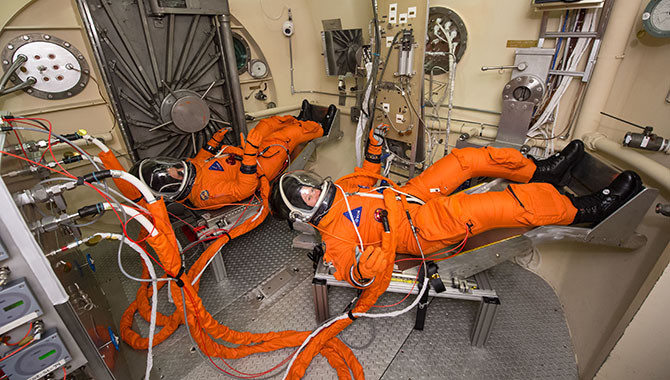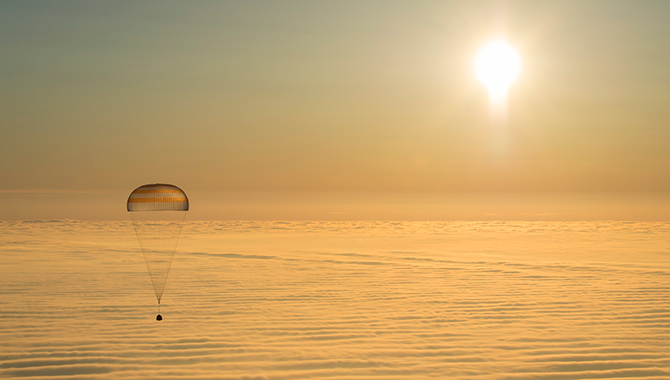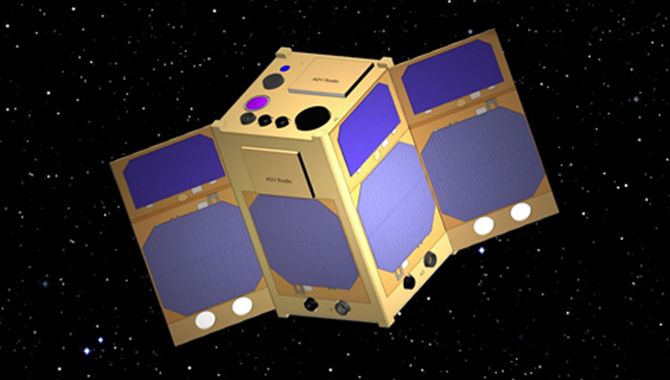
NASA engineers have developed a new spacesuit—the Modified Advanced Crew Escape Suit—to protect crew during Orion deep space missions.
Photo Credit: NASA/Bill Stafford
As NASA’s human spaceflight program passes critical technological milestones, the agency continues its work to examine risks to humans.
NASA supports the advance of human spaceflight in multiple ways. Within low Earth orbit (LEO), the agency is partnering with commercial companies to create a new generation of crew-rated spacecraft. Beyond LEO, NASA continues to mature technologies that will propel manned deep space missions. Orion, the first spacecraft in nearly 45 years designed to send crew to cis-lunar space and beyond, has passed multiple milestones since its 2014 maiden voyage. In September 2015, Orion completed Key Decision Point C (KDP-C), followed by a joint critical design review (CDR) with the Ground Systems Development and Operations (GSDO) Program in March 2016. The Space Launch System (SLS), which will be the most powerful rocket in the world, completed its CDR in October 2015 and the final qualification ground test of its solid rocket boosters in July 2016. In late 2018, Orion and the SLS will fly together for the first time during Exploration Mission 1 (EM-1).
While NASA engineers pursue these and other technological advances, the agency is also taking critical steps to understand and address risks associated with crewed deep space exploration. Spaceflight poses certain risks to human physiology. Long-duration missions can produce a range of physiological changes related to the microgravity environment, including shifts in cardiovascular function and visual acuity as well as loss of bone and muscle mass. To investigate the impact of prolonged spaceflight on the human body, NASA’s Human Research Program (HRP) has established a research-based roadmap, which includes an annual review of NASA evidence reports on potential areas of risk to astronauts during long-duration missions.
Since 2008, NASA has solicited the support of the Health and Medicine Division (HMD) of the National Academies of Sciences, Engineering, and Medicine to assess the validity of the evidence reports. In 2016, the HMD convened a panel of 13 experts in relevant fields, including aerospace engineering, radiation medicine, and human performance. The experts reviewed eight evidence reports from the HRP, which addressed risks associated with radiation exposure, poor team functionality, sleep loss, and sensorimotor changes due to spaceflight.
The committee’s findings are presented in a recently released report: Review of NASA’s Evidence Reports on Human Health Risks: 2016 Letter Report. They concluded that, overall, NASA’s evidence reports are thorough in their review of the risks. The committee’s primary concern was the challenge of establishing interrelationships between risks that are not obviously related. To accomplish this, they suggested adding a standardized section to each report that would highlight interactions between the risk under discussion and risks in other reports. Furthermore, greater investigation into long-term health outcomes—those that occur after an astronaut retires—associated with these risks, rather than the acute effects, could be beneficial.
The 2016 report is the fourth in a series of five, which together will examine more than 30 NASA evidence reports. The reports are used as part of the HRP’s broader initiative to fully assess and address the risks associated with long-duration spaceflight in order to facilitate safe and productive exploration beyond LEO. This activity helps lay the foundation for effective planning of crewed missions to lunar orbit, Mars, and beyond.
Read an APPEL News article about the HMD’s 2015 review of NASA’s human health risk evidence reports.
Read an APPEL News article about the ethics of human space exploration.









